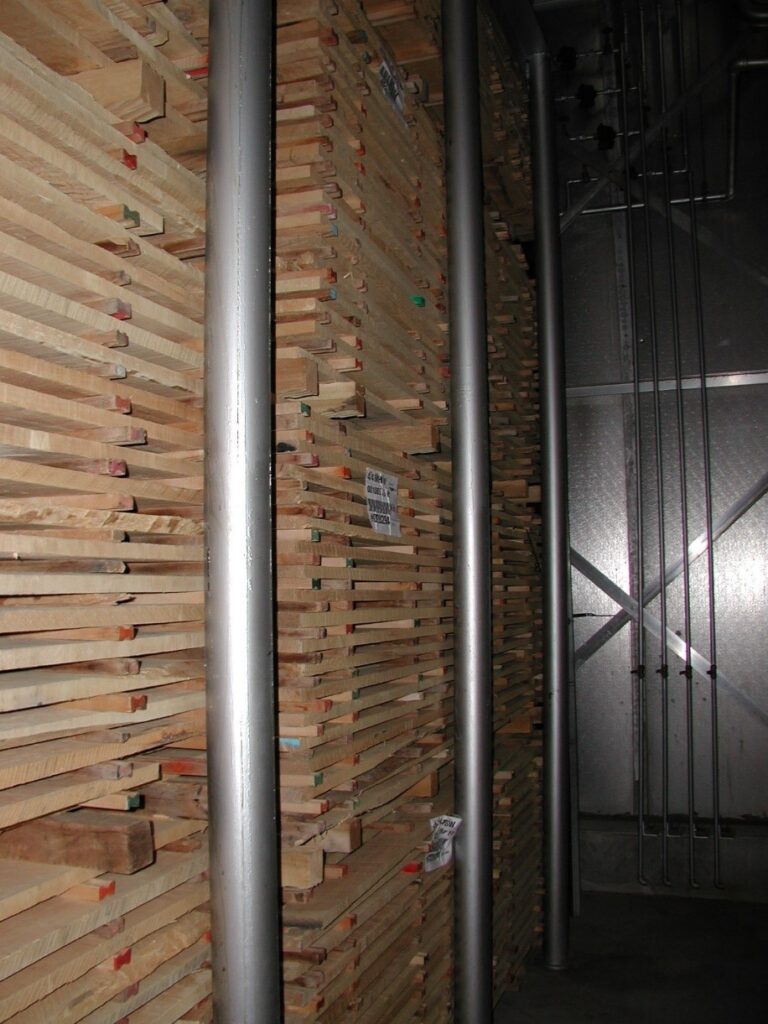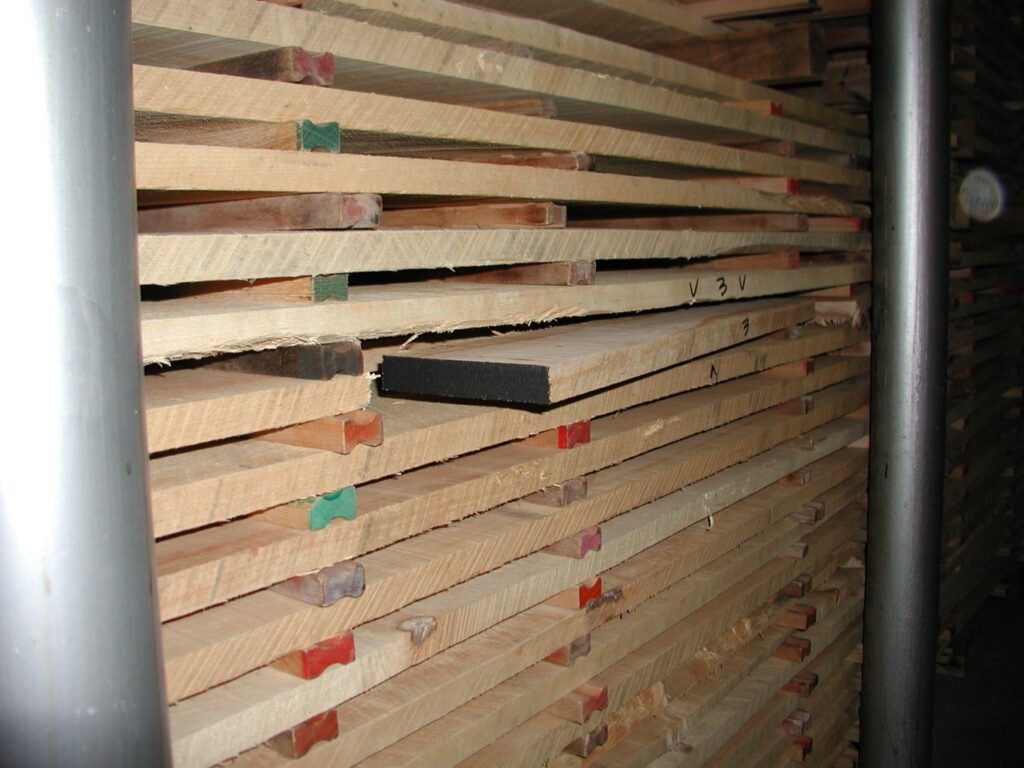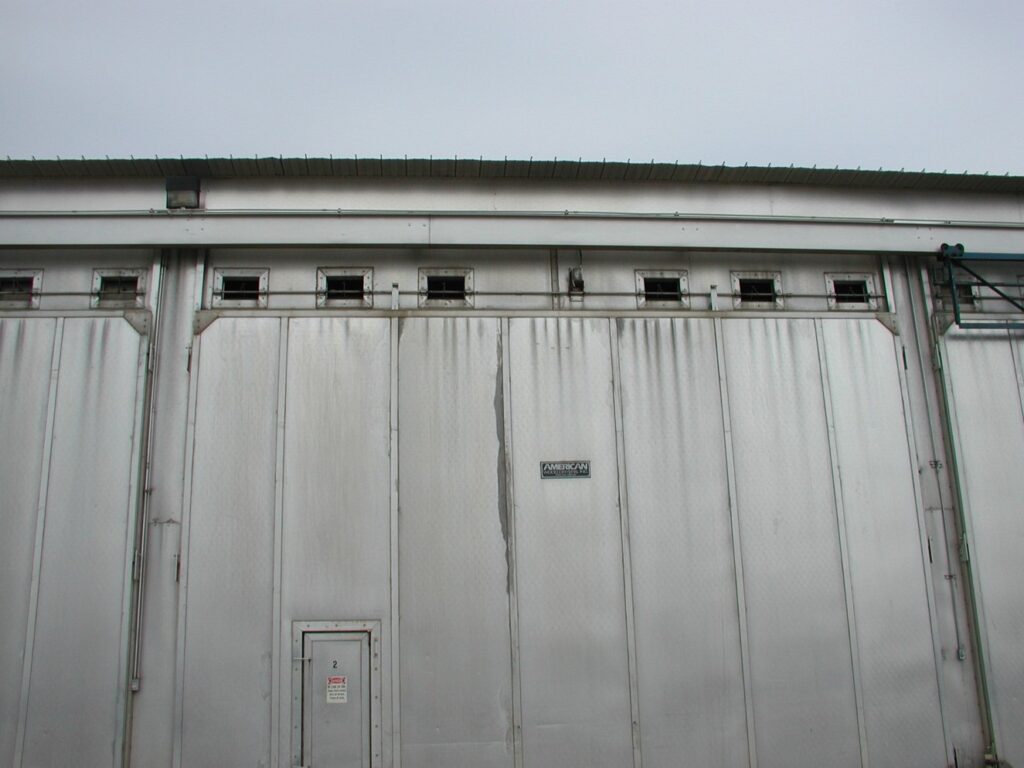By Scott Bowe, Professor of Wood Products at the University of Wisconsin’s Kemp Station and Scott Lyon, DNR Forest Products Specialist, Green Bay
The Great Lake States region produces some of the best hardwood and softwood lumber globally. Most of us have driven by a sawmill or concentration yard and have seen lumber dry kilns — rows of large rectangular buildings with massive doors.
What goes on inside these kilns? What value is added during drying? How many days does it take to dry lumber? Why dry lumber at all?
We dry lumber for several reasons. The first is to prevent fungal degradation and insect attack—a tree in the forest lives in a tough world. Decay fungi, stain fungi and insects are always looking for their chance to use the tree for a food source, home or both.
The wood in a living tree can have a moisture content of 60% to more than 100% (relative to the weight of the wood itself). By drying wood, we render it inhospitable to fungi and most insects. We target moisture content of 8% for hardwoods used in interior applications. For dimension softwoods used in construction, we target a moisture content of 19%.
Drying also reduces weight. Depending on tree species, up to half the weight of green lumber is water. You can transport more dry lumber than green lumber and still meet truck weight requirements. Dry wood is more dimensionally stable, which is critical in manufacturing flooring, millwork, furniture and more. Finally, dry lumber is essential for proper machining and finishing.
Quality drying is important because things can go wrong inside the kiln resulting in defective lumber. Defects include surface cracking (i.e., checking), internal cracking (i.e., honeycomb), warp, twist and internal drying stress (formerly called case hardening).
It is important to note that some degradation can happen before lumber enters the kiln. For example, end checking on logs, sapstain in logs or enzymatic stain in the logs will occur if the logs sit on a landing or in the sawmill log yard for too long. This is especially true for white woods such as sugar maple and red maple. Ideally, lumber cut from a maple log is in the kiln within one week to limit defects.
A kiln is a building where you can control the environment, and control is the key to quality drying. A kiln operator uses heat to increase the temperature, fans to circulate the warm air and vents to expel humidity. Putting green lumber into a kiln as quickly as possible allows a kiln operator to control the temperature, air flow, and relative humidity, reducing defects.
The amount of time it takes to dry lumber will depend on species and thickness. Most softwood dimension lumber is dried in hours versus days. For example, pine two-by-fours use a time-based schedule of 24 to 36 hours to dry.
The goal with softwood dimension lumber is to produce a strong component for a building structure, and appearance is not a concern. Hardwood lumber is more finicky. One-inch-thick hard maple (i.e., four-quarter) can dry in about 10 days from green to 8%. Four-quarter red oak lumber, a more difficult species to dry, will take about 30 days from green to 8%. You could dry hardwood lumber on a softwood schedule, but it would come out of the kiln cracked and in pieces — useful for firewood and nothing else. In general, the thicker the lumber — the longer it takes to dry.
Whether you are drying hardwoods or softwoods, stickering the lumber is important. Stickers are long narrow sticks of wood that separate the courses of lumber (Figure 1, allowing for proper airflow through the lumber stack to reduce the moisture content.
It is important to place stickers close to the ends of the boards to reduce end checking and other drying defects such as warp. Also, stickers must be vertically aligned to distribute lumber weight in the vertical stacks evenly.
We mentioned previously that most softwoods dry on a time-based schedule — remember Ron Popeil’s rotisserie oven “Set it and forget it!” It is that easy. Hardwood lumber is more difficult to dry, and care must be taken to produce a product without visual or internal defects.
To better monitor drying, sample boards are used to monitor the drying rate and any defects that form during drying (Figure 1). Sample boards (Figure 2, see board #3) are placed within the units of lumber. These samples are removed from the kiln and weighed to determine the daily loss of moisture content, then returned to the kiln until the next day’s weighing. This process allows the kiln operator to monitor the lumber’s moisture loss and adjust the kiln controls.
Some kiln operations do not use sample boards. They use electric probes that are drilled into the lumber to estimate moisture loss. Technology like this is becoming more common, but many kiln operators use samples in addition to probes, so they can visually monitor the samples for defects.
Consider a kiln that contains 40,000 board feet of 4/4 FAS sugar maple (high-end grade lumber). In today’s market, it has a value of $113,400. This valuable kiln of lumber proves it is a good idea to have multiple ways to monitor quality in the drying process.

Figure 1: Inside a fully loaded kiln showing sticker placement for proper airflow.

Figure 2: One of several 30-inch sample boards shown in a kiln. Note that end sample board #3 has been sealed to limit excessive-end drying.
Table 1 shows a typical drying schedule for sugar maple. The kiln operator sets the kiln controls based on the initial moisture of the lumber as it is loaded into the kiln.
For example, a load of freshly sawn sugar maple will have a moisture content of around 65%. That would place it in the above 30% category, as shown in the first column. The operator would then set the temperature to 100 degrees and the fan speed to the highest possible setting.
White woods, like maple, benefit from low initial temperatures with high fan speed. The high fan speed will evaporate surface moisture on the lumber (preventing fungal staining), and the low temperatures will help maintain a white color.
Table 1. White maple drying schedule (T1-C5). A common schedule is used to dry hard maple (sugar maple), resulting in a lighter color.
| Moisture content | Equilibrium moisture content | Relative humidity | Dry-bulb | Wet-bulb depression |
| ———————————-(%)——————————- | ——————-(o F)——————- | |||
| Above 30 | 11.8 | 68 | 100 | 10 |
| 25 to 30 | 9.8 | 58 | 105 | 14 |
| 20 to 25 | 7.6 | 44 | 105 | 20 |
| 15 to 20 | 4.1 | 22 | 115 | 35 |
| <15 | 3.3 | 17 | 120 | 45 |
Relative humidity inside the kiln is controlled through venting. For example, Table 1 shows the relative humidity of 68% for the above 30% setting. Early in the drying stage, the wood will give off a lot of water causing the relative humidity to rise quickly. Airflow in a kiln is circular.
Fans blow warm, dry air through the units of lumber. This cooler wet air is vented through top vents on one side of the kiln (Figure 3), while fresh dry air is drawn into the kiln through vents from the other side of the kiln and heated. Then the process starts all over again. These vents are automatically opened and closed as needed to maintain the set relative humidity.

Figure 3: Kiln vents in the open position shown along the top of the kiln. Similar vents are located on the backside of the kiln.
Most kilns in the Great Lake States area are steam heated with wood biomass fuel. Since many sawmill companies also dry lumber, they readily produce bark and chips that can be burned to produce steam. Natural gas, propane and other fuels are used to produce steam, but costs may be prohibitive.
It is also worth mentioning that other types of kilns do not use steam for heat. The second most common type of drying is called dehumidification drying. In this system, moist air is not vented out of the kiln but is dehumidified, then recirculated in the kiln. Wood heated steam kilns are the most common technology used in the Lake States.
Table 1 shows that as the wood continues to dry, the kiln operator increases the temperature and decreases relative humidity. More energy is needed later to remove moisture down to the 8% target.
The last two steps in drying are called equalizing and conditioning. The idea is to bring all boards to an equal moisture content in the equalizing stage. Freshly sawn boards are all close in moisture content, but they can vary by a few percentage points.
By setting the conditions in the kiln to over-dry the lumber to 6%, all boards will eventually reach 6%. Now that the boards inside the kiln are equal at 6%, we can start conditioning to relieve any drying stresses in the lumber.
Temperature, moisture gradients and shrinkage are all factors that cause drying stresses. By injecting live steam into the kiln, the lumber is heated and plasticized, relieving the stress. Stress relief is necessary for remanufacturing by machining or resawing.
If you are a woodworker and notice the sawblade being pinched when resawing lumber, that shows the board is not properly conditioned and stress is present. Adding water to the steam raises the final moisture content to the target of 8%, and the lumber is ready to be removed from the kiln.
It is important to note that dried lumber must be cared for. If dried lumber gets wet from rain or snow or is placed in a very humid environment, its moisture content will increase. Dried lumber should be kept under a roof and ideally in a conditioned space to maintain its final moisture content (8%). Secondary manufacturers such as flooring plants, furniture plants, etc., often humidify their production floor in the winter to keep the lumber from getting too dry.
This was a quick peek inside a lumber dry kiln—one of the many processes that adds value to Wisconsin’s raw materials.
Photos courtesy of Kretz Lumber Company Inc., Antigo, Wisconsin.
